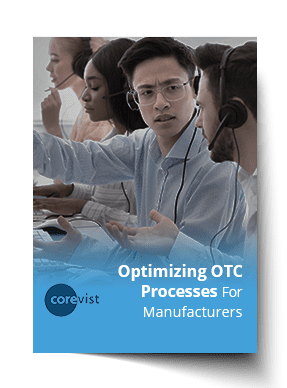Share
Author
George Anderson
Share
Reducing waste in customer service
In the post-COVID world, manufacturers are grappling with rapid shifts in demand, staffing capacity, and fulfillment capacity. Efficiency is the name of the game to prepare for the next disruption.
Many manufacturers depend on phone, fax, and email for routine customer service inquiries–and this is a prime target for cost optimization.
But where should manufacturers start in reducing their cost to serve? Here are 3 ideas.
1. Eliminate phone inquiries about order/account status
If you’re reducing waste in your OTC process, where do you start? What low-hanging fruit can you address quickly?
For many manufacturers, manual inquiries about the status of orders, invoices, and credit offer a great opportunity to increase OTC efficiency. This basic information doesn’t require human communication to add nuance or value. There’s no negotiation involved, and no need for the manufacturer to control the conversation. The information requested is simply factual—the status of an order, the credit status of the account, the due date on an invoice.
NEW Report:
Optimizing OTC Processes for Manufacturers
Every manufacturer needs to become more efficient. Here’s the ultimate guide to optimizing your OTC cycle. Read now.
What’s more, manual presentation of this data isn’t scalable. A Customer Service rep can only serve one customer at a time, so your cost to serve will scale up alongside inquiry volume.
This is why routine inquires are a great candidate for transitioning to a self-service digital portal. If you could offer real-time data for orders, invoices, and credit in a digital customer portal, you could eliminate routine status inquiries via phone and email.
If you can move these inquiries to self-service, you’re making great strides. The key is a solution that includes real-time, personalized SAP integration for each customer. (That’s the thinking behind Corevist Order Tracking.)
2. Eliminate manual inquiries about freight costs
Do your channel partners craft orders to fill up a truckload, so they can save on freight costs?
If so, this is a great place to increase efficiency in your OTC cycle. Getting that information through a CSR (customer service representative) isn’t scalable, as it requires back-and-forth communication—plus manual calculation of product weight to fill up a truckload without going over the limit.
So how do you give your customers full control of truckload utilization (and, thus, optimal freight value)?
Believe it or not, you already have all this information in SAP ERP.
If your SAP ERP system is configured following best practices, each material in SAP should have a weight associated with it. If you have an ordering portal integrated to SAP (like Corevist Commerce), you’ll want to present line item weight and total order weight in the cart. (Corevist supports this functionality).
With visibility into total order weight, your buyers can track the weight of their order as they add products. With line item weight, they can figure out what products to remove from the order if they’ve gone over the limit—or choose the right product to use up the last space on the truck and optimize their freight costs.
Read more here: Personalized Picklists + Lowest Possible Freight Charge.
3. Replace paper-based payment processes with self-service
Are you still depending on paper invoices and checks in the mail to get paid?
If so, your A/R processes offer a prime opportunity to increase efficiency in your OTC cycle. With a digital account portal, you can give customers everything they need to process payments through self-service (as long as the portal includes full integration to SAP ERP):
- View open items in real time from SAP
- View open invoices in real time from SAP
- View credit status in real time from SAP
- Pay open invoices with payment methods of your choice (ACH, credit/debit card, eCheck, Paypal, and more)
- Post transactions instantly to SAP ERP
With a digital account portal in place, you can eliminate inefficient paper-based processes and the back-and-forth communication that they require. This is why A/R offers a great opportunity for increasing operational efficiency.
The Takeaway
A self-service portal for post-order care eliminates unnecessary cost in your OTC cycle. When you give customers a portal for order tracking, account management, and invoice payment, you reduce the burden on your Customer Service staff, which empowers them to focus on value-added tasks. The result is a smoother operation, better customer experience, and lower cost.
NEW Report:
Optimizing OTC Processes for Manufacturers
Every manufacturer needs to become more efficient. Here’s the ultimate guide to optimizing your OTC cycle. Read now.










